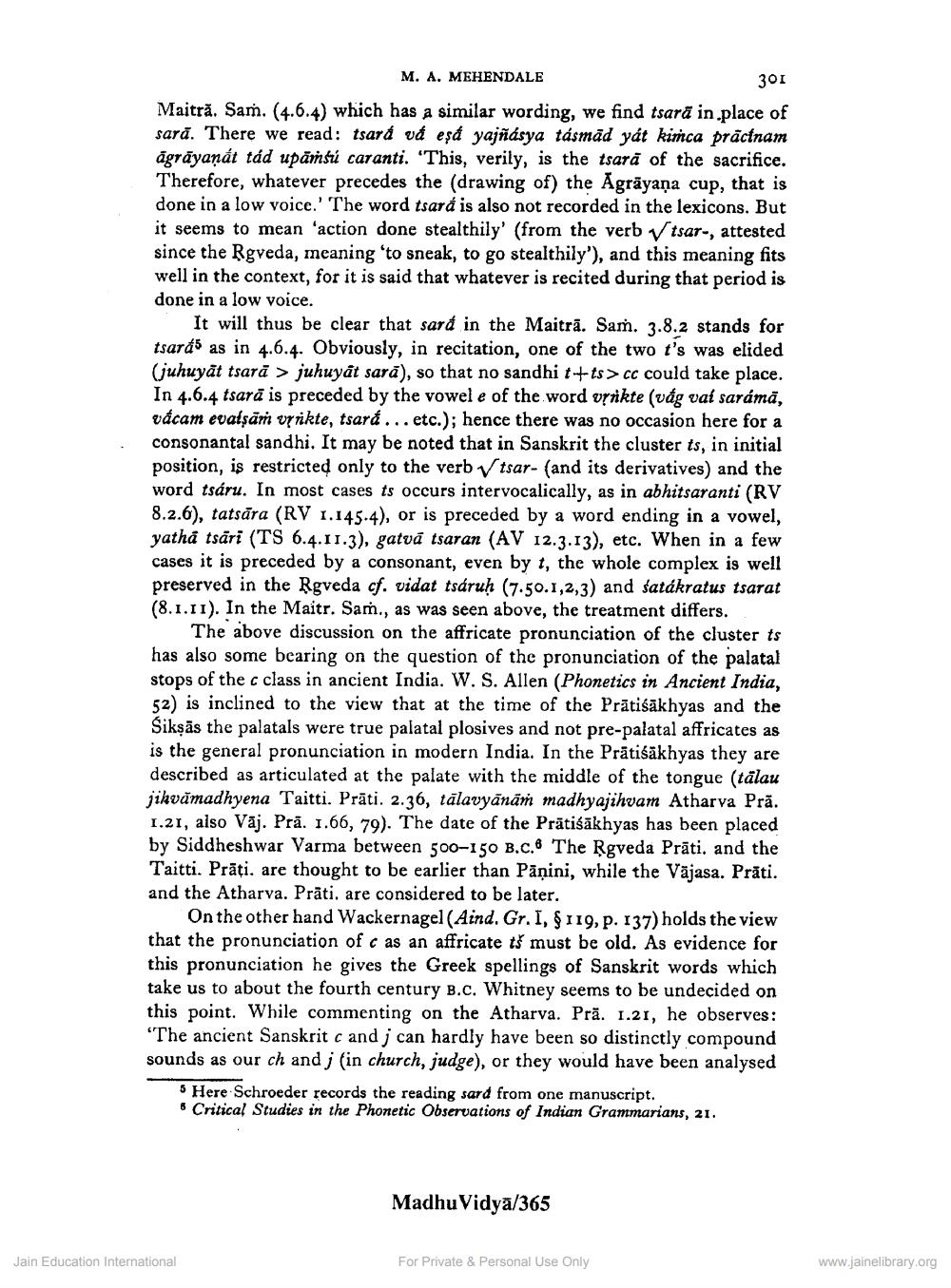________________
M. A. MEHENDALE
301
Maitra. Sam. (4.6.4) which has a similar wording, we find tsara in place of sard. There we read: tsará vd esd yajñdsya tásmad yát kimca práctnam agrāyaṇát tád upăṁsú caranti. "This, verily, is the tsara of the sacrifice. Therefore, whatever precedes the (drawing of) the Agrāyaṇa cup, that is done in a low voice.' The word tsará is also not recorded in the lexicons. But it seems to mean 'action done stealthily' (from the verb √tsar-, attested since the Rgveda, meaning 'to sneak, to go stealthily'), and this meaning fits well in the context, for it is said that whatever is recited during that period is done in a low voice.
It will thus be clear that sard in the Maitra. Sam. 3.8.2 stands for tsards as in 4.6.4. Obviously, in recitation, one of the two t's was elided (juhuyāt tsarā > juhuyāt sard), so that no sandhi t+ts> cc could take place. In 4.6.4 tsard is preceded by the vowel e of the word vṛikte (vág val sarámā, vácam evalṣām veikte, teard... etc.); hence there was no occasion here for a consonantal sandhi. It may be noted that in Sanskrit the cluster ts, in initial position, is restricted only to the verb tsar- (and its derivatives) and the word tsáru. In most cases ts occurs intervocalically, as in abhitsaranti (RV 8.2.6), tatsära (RV 1.145.4), or is preceded by a word ending in a vowel, yatha tsari (TS 6.4.11.3), gatva tsaran (AV 12.3.13), etc. When in a few cases it is preceded by a consonant, even by t, the whole complex is well preserved in the Rgveda cf. vidat tsáruḥ (7.50.1,2,3) and latákratus tsarat (8.1.11). In the Maitr. Sam., as was seen above, the treatment differs.
The above discussion on the affricate pronunciation of the cluster tr has also some bearing on the question of the pronunciation of the palatal stops of the c class in ancient India. W. S. Allen (Phonetics in Ancient India, 52) is inclined to the view that at the time of the Prätisakhyas and the Siksäs the palatals were true palatal plosives and not pre-palatal affricates as is the general pronunciation in modern India. In the Prätisakhyas they are described as articulated at the palate with the middle of the tongue (talau jikvämadhyena Taitti. Präti. 2.36, tälavyānāṁ madhyajihvam Atharva Pră. 1.21, also Vaj. Prä. 1.66, 79). The date of the Prätiśäkhyas has been placed by Siddheshwar Varma between 500-150 B.c. The Rgveda Präti, and the Taitti. Prāti. are thought to be earlier than Panini, while the Vajasa. Prāti. and the Atharva. Prāti. are considered to be later.
On the other hand Wackernagel (Aind. Gr. I, § 119, p. 137) holds the view that the pronunciation of e as an affricate t must be old. As evidence for this pronunciation he gives the Greek spellings of Sanskrit words which take us to about the fourth century B.C. Whitney seems to be undecided on this point. While commenting on the Atharva. Pra. 1.21, he observes: "The ancient Sanskrit e and j can hardly have been so distinctly compound sounds as our ch and j (in church, judge), or they would have been analysed
Jain Education International
5 Here Schroeder records the reading sard from one manuscript.
5 Critical Studies in the Phonetic Observations of Indian Grammarians, 21.
Madhu Vidya/365
For Private & Personal Use Only
www.jainelibrary.org




